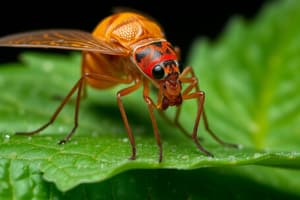Podcast
Questions and Answers
What type of host acts as a bridge between the intermediate host and the definitive host?
What type of host acts as a bridge between the intermediate host and the definitive host?
- Paratenic host (correct)
- Dead-end host
- Accidental host
- Definitive host
Which type of host cannot progress the life cycle development of the parasite?
Which type of host cannot progress the life cycle development of the parasite?
- Dead-end host (correct)
- Intermediate host
- Paratenic host
- Definitive host
What is the term used for a symbiotic relationship where both organisms benefit from each other's existence?
What is the term used for a symbiotic relationship where both organisms benefit from each other's existence?
- Parasitism
- Commensalism
- Mutualism (correct)
- Phoresis
In the context of parasite-host relationships, what is an example of a dead-end host for the Japanese encephalitis virus?
In the context of parasite-host relationships, what is an example of a dead-end host for the Japanese encephalitis virus?
What is the primary role of a paratenic host in a parasite's life cycle?
What is the primary role of a paratenic host in a parasite's life cycle?
Which type of symbiotic relationship involves one organism benefiting and the other being unaffected?
Which type of symbiotic relationship involves one organism benefiting and the other being unaffected?
What is the main difference between parasitism and commensalism?
What is the main difference between parasitism and commensalism?
What is the primary purpose of adaptations in parasites?
What is the primary purpose of adaptations in parasites?
Why do endoparasites usually lack feeding organs?
Why do endoparasites usually lack feeding organs?
Which statement best describes the impact of parasitism on the host?
Which statement best describes the impact of parasitism on the host?
What is a common characteristic of commensals in symbiotic relationships?
What is a common characteristic of commensals in symbiotic relationships?
Why do endoparasites often have highly reduced or absent locomotory organs?
Why do endoparasites often have highly reduced or absent locomotory organs?
What type of parasites live on the surface of the host's body?
What type of parasites live on the surface of the host's body?
Which parasite has attachment organs like rostellum, hooks, or suckers to connect securely to the host's organs?
Which parasite has attachment organs like rostellum, hooks, or suckers to connect securely to the host's organs?
Which parasite has a highly muscular pharynx for easy absorption of food materials from the host?
Which parasite has a highly muscular pharynx for easy absorption of food materials from the host?
What type of parasite lives in the interior of the host's body, in the blood, tissues, body cavities, and other organs?
What type of parasite lives in the interior of the host's body, in the blood, tissues, body cavities, and other organs?
Which parasite leads a parasitic condition throughout its entire life cycle?
Which parasite leads a parasitic condition throughout its entire life cycle?
Which term describes organisms that can live either a parasitic or non-parasitic existence depending on opportunity?
Which term describes organisms that can live either a parasitic or non-parasitic existence depending on opportunity?
Flashcards are hidden until you start studying




